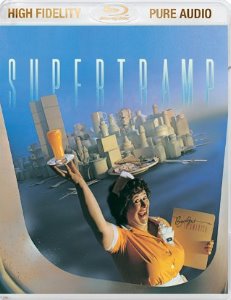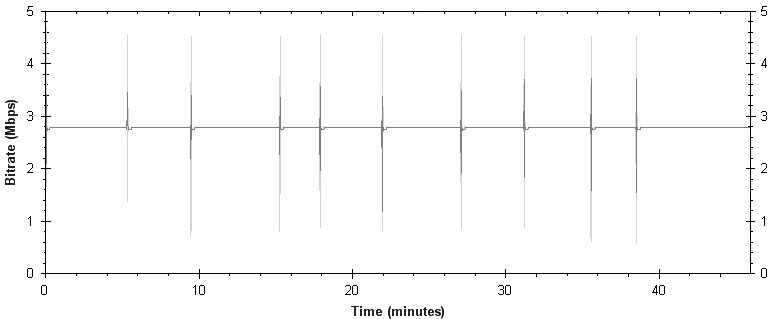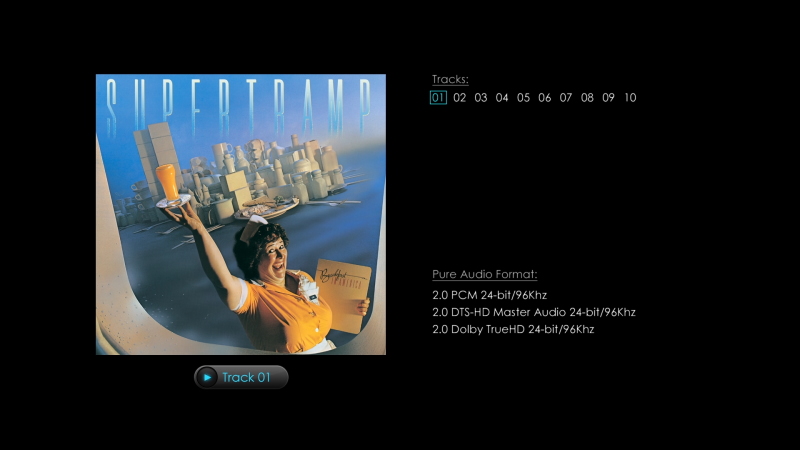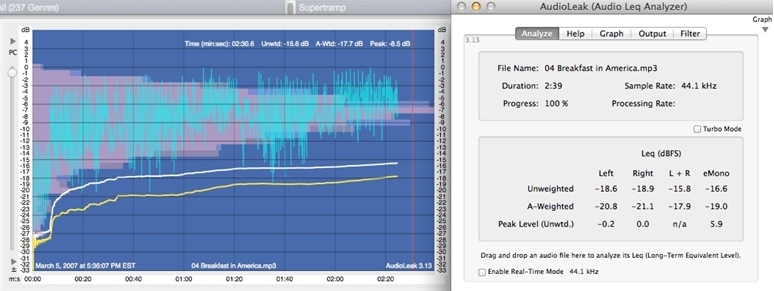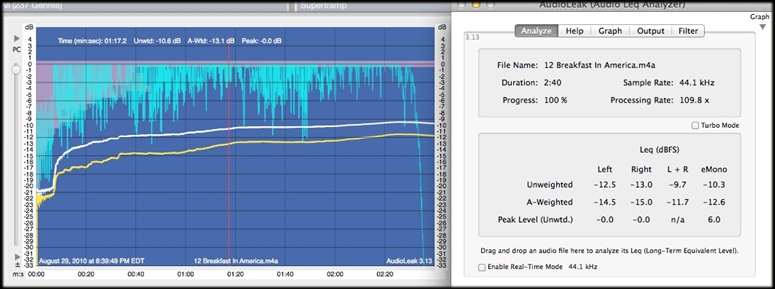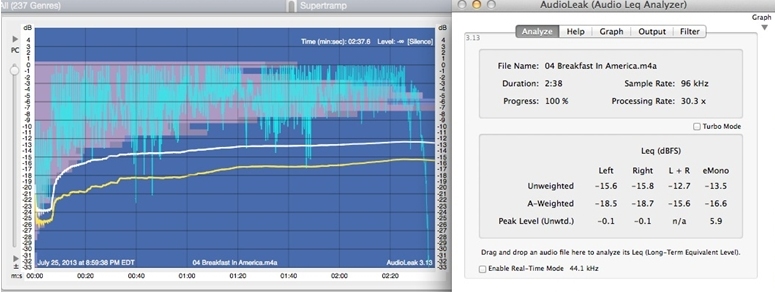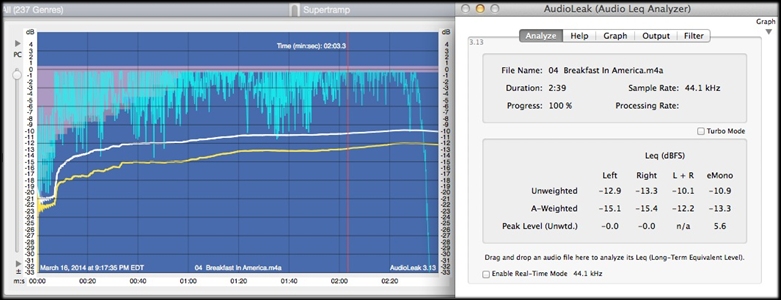|
Supertramp
- Breakfast in America [Blu-ray
Audio]
Review by Gary Tooze
Producer: Universal
Music Group
Disc:
Region: FREE!
(as verified by the
Oppo Blu-ray player)
Total Music time: 0:45:57.755
Disc Size: 5,675,238,901 bytes
Bitrate: Audio is encoded at 24/96 (24 bit depth and 96kHz
sampling rate)
Chapters: 10 (one per song)
Case: Transparent Blu-ray case
Release date: October 30th, 2013
Audio:
LPCM Audio
English 4608 kbps 2.0 / 96 kHz / 4608 kbps / 24-bit
DTS-HD Master Audio English 3653 kbps 2.0 / 96 kHz / 3653
kbps / 24-bit (DTS Core: 3.0 / 48 kHz / 1509 kbps / 24-bit)
Dolby TrueHD Audio English 3049 kbps 2.0 / 96 kHz / 3049
kbps / 24-bit (AC3 Embedded: 2.0 / 48 kHz / 640 kbps)
Extras:
A
foldout with photos and lyrics and extensive description of
the recording process of the album. A paper with a code to
access the Blu-ray disc digital downloads online
Produced By: Supertramp and Peter Henderson
Supertramp - Breakfast in America Track Listing:
1. Gone Hollywood (05:18.35)
2. The Logical Song (04:08.91)
3. Goodbye Stranger (05:47.93)
4. Breakfast in America (02:37.69)
5. Oh Darling (04:03.15)
6. Take the Long Way Home (05:08.89)
7. Lord Is It Mine (04:06.78)
8. Just Another Nervous Wreck (04:21.92)
9. Casual Conversations (02:57.01)
10. Child of Vision (07:27.07)
Comparison material:
•
Canadian CD (CD 3708, A&M Records) circa 1990
•
Japan SHM-CD Demo Disc from December 2008 "Have You Ever
Been Experienced? SHM-CD Compilation Volume 3: Rock Edition”
(UICY 91296) - This demo disc includes a regular CD and an
SHM (Super High Material) CD which is supposed to have
improved optical properties for better bit extraction by CD
players.
•
Japan SHM-SACD (UIGY-9536)
•
UK Deluxe Edition from 2010 (0600753304389) includes a
second disc with live songs from 1979, some not appearing on
the live album Paris.
Bitrate:
Album:
‘Breakfast in America’ is Supertramp’s sixth studio
album: They were a band at the top of their game. The
resulting 120 date world tour, double-live album (‘Paris’)
and massive popularity of this record resulted in some
conflict which was to result in a strained 7th album
(‘…Famous Last Words…’) and an ultimate schism within the
band. But what a record it was: it is sadly regarded as the
‘last great’ Supertramp album. Beautifully written, wistful.
Wonderfully performed and recorded, I chose this as an album
for review for DVDBeaver because of the intersection of (1)
potentially wonderful source material and (2) a promising
new Blu-ray Audio format.
RIAA Sales: Quadruple platinum.
Singles: 4 in the USA, 2 in the UK
Awards: 2 Grammys 1980 - Best Engineered Recording, Non
classical and Best Album Package
Charting: Number 1 in the USA for 6 weeks. Number 1 in
Canada, Austria and Australia.
Interesting trivia : This album is the best-selling English
album of all time in France (and 3rd overall there) .
Supertramp has always had a huge following in France as well
as French-speaking Quebec. Their albums seem to chart and
sell better outside of the UK. The Paris recording was
apparently chosen for the live album release as a thank you
to the French fans and apparently Montreal was also an
option for that selection.
The Album:
Ironically, this album was to have been called ‘Hello Stranger’
and concentrate on the differing beliefs and contrasting styles of
songwriters Davies and Hodgson. The album was to represent a
back-and-forth dialogue between the two, also reflecting their habit of
writing songs independently but with a mutually chosen theme. Instead,
they chose for a lighter ‘fun’ look and feel. There are conflicting
reports of Davies’ and Hodgson’s interactions during the recording,
ranging from ‘friendly' and 'never-better', to quiet, non communicative
and strained. We still don’t know all the relative contributions of each
to the album, as they are contractually both listed as writers on all
songs, but they refer to a rough 5 and 5 split. Like many classic bands,
artistic contributions and differences seemed to make this album greater
than the sum of its parts. The fun portrayal of the US on the cover and
in some of the track material was not a dig at Supertramp’s American
members but as a tribute and theme of sorts. If you are a fan of
Supertramp, you know all of these songs. If you are new to them, you can
do no better than to choose this album as a wonderful representation of
their art. If your tastes in music run towards darker or more serious
themes, perhaps ‘Even in the Quietest Moments’ or ‘Crime of the Century’
would be best. Critics have always derided the band for a degree of self
pity in the songwriting, but the human condition does not lend itself to
unbridled joy. On a personal note, this was the album of my 13th summer.
I wore out a cassette tape that traveled with me everywhere, including
my first trip to Europe. It was an excellent traveling companion. The
cover’s portrayal of New York city before 9/11 is a bittersweet reminder
of the WTC and what already seems like another era to most of our
generation.
Audio: Audio reviewing risks
always being highly subjective. I think it is nonetheless
best to report subjective real-world impressions first and
try to provide supporting data by analysis if possible. You
work hard for your money and when deciding on innumerable
formats I believe you should have the information to make an
empowered decision. The record companies should also work
hard for your dollars and strive to provide you with value
and make good-faith efforts to use technologies available to
offer you the best. This review will be slightly longer to
illustrate a few points about modern digital audio.
On initial listening, as with many modern releases,
Breakfast in America [Blu-ray]
sounds bright and slightly louder than original CD releases.
With prolonged listening however, it seemed slightly
grating. Fan reviewers on Amazon had conflicting opinions.
One reviewer went so far as to retract an initial impression
and withdraw his approval of this release. I think that was
telling as it was my exact reaction. So off to some analysis
to try and discover the roots of my disappointments. For
review purposes, I extracted the audio from this title to
its’ 24/96 PCM track. First, I did some comparison using 2
versions: a totally uncompressed AIFF format as well as
Apple Lossless Audio Codec, which, like FLAC, is supposed to
result in a bit-perfect representation of the original .wav
audio (uncompressed). The purpose of this was to see if the
extraction to a lossless format mattered. As expected, the
format did not matter - subjectively both still sounded
louder and a little compressed compared to my original CD.
Analysis of the audio loudness levels, dynamic range were
identical. Some audiophiles purport to hear a difference
between lossless formats and ‘pure’ formats like .wav or .aiff.
The only way I can imagine this matters is if software of a
computer is not up to the task of converting the audio back
to the pure bit-perfect original data upon playback.
Sufficient processing power, data buffering, and software
that operates in a bit perfect mode should solve this issue,
while permitting smaller file sizes. This matters for high
resolution audio, since individual songs can be a quarter of
a gigabyte!
I tried subjective comparison with what I assumed would be a
high end CD release. The
Blu-ray was, however, still far
better than the audio track from the Japanese
SHM-CD demo
disc “Have
You Ever Been Experienced? SHM-CD Compilation Volume 3: Rock Edition” - UICY 91296. This special release
included a regular Japanese CD and
SHM-CD (Super High
Material) version for the same 19 demo tracks for comparison
purposes. Regardless of the format, both this Japanese CD
and
SHM-CD are terribly loud and compressed. A disaster, in
my opinion for audio. Analysis with foobar2000 for windows
with the Dynamic Range analysis plugin shows a miserable 7
dB (DR score 7) of dynamic range. The source for this
material is newly remastered. Ironically, the original
1990-ish CD was superior in terms of dynamics, musicality
and was pleasing to the ear, even on prolonged listening.
So how did they
Blu-ray audio fare by comparison? For similar
tracks, the tracks reveal a dynamic range score of 10.
As I was preparing this review, my purchased copy of
'Breakfast in America' (UIGY-9536) on the purist’s dream
format of
SHM-SACD arrived from Japan. The difference is
audible and palpable. Once adjusting for volume levels, the
SHM-SACD is clearly superior in dynamics and detail and
lacks the harshness associated with the
SHM-CD and, to a
lesser degree, with the
Blu-ray. As a hobbyist, I am able to
analyze the DSD audio on SACD releases using the obscure PS3
method to obtain the tracks.
Once analyzed by foobar2000, they give a DR score of 12-13.
Analysis on the Mac using the
paid version of ChannelD’s Audio LEq tool reveals the
following for the 3 formats
(1) Original CD - even an old mp3 rip for analysis reveals
full dynamics. Foobar2000 DR score of 13 ! As with many
older CDs, even with volume adjustment, the frequency
response subjectively seems a little flat (CD or Mp3).
(2)
Japan SHM-CD Demo Disc with evidence of lots of compression. Foobar DR score of 7. Worst of all formats here.
(3)
Blu-ray Audio - pushed to the limit with evidence of only very
slight compression. Foobar2000 DR score of 11.
(4) Of note the
Japanese SHM-SACD, played through foobar2000 with the
SACD plugin also gives the DR score of 13. Since DSD audio is a
completely different technology, it is not possible to analyze without
conversion to some other PCM format first. The presence of the highest
DR score would strongly argue that it is not compressed, however.
(5)
UK Deluxe Edition from 2010 played through foobar2000 gives a DR
score of only 8. It is visibly compressed
Ironically, 35 years after the release of this album, I have
to pay about $60 for the Japanese
SHM-SACD to get the full
dynamics and detail of this wonderful recording. The
original CD purchased around 1990 is the next best in terms
of dynamics although the
Blu-ray comes close. It does seem
brighter and fuller in terms of frequency response
subjectively but as mentioned, still slightly grating on
prolonged listening. The Japanese
SHM-CD demo is the worst
of all the formats analyzed. Although the loudest and
brightest on initial listening, it is over compressed and
punched up. It represents just about everything that is
wrong with modern music releases. If you Google ‘loudness
wars’ there are many examples of classic recordings ruined
by overly aggressive volumes/compression used on
re-mastering. My best advice is don’t rush to throw out your
original CDs but rather, get reacquainted with a good
amplifier and its volume knob. Once you are comparing at
similar volume levels, you’ll hear that the old ‘flat’ CD
really has more dynamics and a fuller sound.
I think it is critically important to go to Universal’s
statement on
Blu-ray audio to see where my disappointment
comes from. - The claim from Amazon’s website and found on
numerous high end audiophile retailers (like MusicDirect and
ElusiveDisc) says: Universal Music Group has gone back to
the original master tapes to deliver fully uncompressed,
high-resolution versions of many of your favorite albums on
Blu-ray Pure Audio Disc. Mastered at 24bit/96kHz,
Blu-ray
Pure Audio Discs deliver the sound the artists originally
heard in the studio when these classic albums were recorded.
Recordings are transferred from the original master tapes
and delivered in high-resolution 24-bit/96kHz audio. "No
compression is utilized, and the sound quality is vastly
superior to MP3 or standard CD. "
None of those things in the statement are necessarily true
or false. While going to an original source is usually
preferable and while
Blu-ray is more than capable of
delivering on these promises, in actual execution, decisions
made during mastering can ruin the dynamics of a recording.
In this particular case, they are right at, and probably a
little past maximum on volume selection in this release. The
SHM-SACD and original CD (ironically) would seem to support
that. An initial analysis of Lenny Kravitz’s ‘Are You Gonna
Go My Way’ strongly suggests that compression is used, even
in that release which is 24/192. 24 bit digital audio has a
theoretical maximum signal to noise range of 144 dB,
compared to 96 dB for 16-bit CD audio. Most recordings in
rock fit well within either paradigm but the additional
headroom afforded by high resolution formats, to my mind,
provide no excuse for compression.
I also don’t wish to give the impression that a DR score is
all that it takes to evaluate music. This would be perilous.
Some music has little dynamic range, inherently. Other
times, a compressed version taken from a batter master with
new remastering techniques will clearly best original CDs.
One example is the Sam Cooke track ‘Another Saturday Night’
from an older compilation ‘The Man and His Music’. Although
the original CD has dynamics by analysis, it sounds
terrible; almost like an AM radio recording with respect to
frequency response. Conversely, the SACD release ‘Portrait
of a Legend 1951-1964’ has less dynamics on analysis, but
sounds like a different recording altogether. Part of ABKCO’s DSD remaster series, it sounds like it could have
been recorded today. It is being reissued on
Blu-ray audio,
and I can’t wait to compare it to the other formats. One
thing I have learned is that generalizations must be
avoided. Each recording and reissue must be taken on its own
merits.
The
Oppo
has identified
it as being a region FREE disc (like CDs) playable on
Blu-ray
machines worldwide.
Extras :
A
foldout with photos and lyrics and extensive description of
the recording process of the album. A paper with a code to
access the
Blu-ray
disc digital downloads online
Produced By: Supertramp and Peter Henderson
BOTTOM LINE:
My recommendations are therefore as follows: Since as of the time
of writing this review the only high-resolution formats for
‘Breakfast in America’ are the
Blu-ray audio and
SHM-SACD,
the
Blu-ray represents reasonably good value in terms of
providing a good listening experience with full frequency
yet somewhat muddled dynamics. The downloadable files allow
you to listen on a music server or via a portable device
easily. In this day and age of music servers, high speed
internet connections and sites like HDtracks.com I would
recommend to Universal that a 24/96 or greater high
resolution download become part of the
Blu-ray audio
program. I think it would support sales strongly.
Furthermore, they could include the option of uncompressed
and compressed versions either for download or on the discs
(which have tremendous capacity). It is not without
precedent: HDTracks has done so for Paul McCartney’s 24/96
releases, all of which are offered in compressed or
uncompressed versions.
Sadly, I must warn you to be wary of just about all CDs
produced in the last 10-15 years as they risk being overly
compressed. Read reviews first. For example, the only reason
I can recommend the 2010 2
CD Deluxe Edition is if you must
have the live tracks from 1979 or are a Supertramp collect
but caveat emptor RE sound quality. Surprisingly, the
Japanese SHM-CD format is the worst of the lot, with extreme
compression. I can’t recommend a release that gives me a
headache - this degree of compression might do well in
specific environments, like radio play, a waiting room, or a
car stereo, but it fails miserably for what is marketed as
an audiophile SHM release. The message here is that
mastering is much more important than the format these days.
There are contrarian opinions about this trend but I
vehemently disagree, especially when the technology could
easily give us both versions.
However, if you have SACD playback capability and want a
definitive digital version of this album, I cannot say
enough about the
SHM-SACD, which is already getting
difficult to find. If you can afford it and love this album
as much as I do, I cannot recommend the
Blu-ray over the SACD. I think it's worth the premium for a recording of this
quality and popularity.
Summary: Worst to Best
Format / Release: DR Notes:
Score:
Japan SHM-CD remaster
7 Terribly loud and compressed
UK Deluxe Edition from 2010
8 Loud and compressed. Only recommended
for bonus live material
1990 Out of Print Original CD 13 Full dynamics, frequency
response slightly flat
2013 Blu-ray Audio
11 Mild compression, nice frequency
response, includes CD quality download
**WINNER:
Japan SHM-SACD**
13 **Hands Down BEST. Best sound
& dynamics. Audiophile reference quality**
Daniel Lalla
March 19th, 2014
|
![]()
![]()

![]()
![]()
![]()
![]()

![]()
![]()












